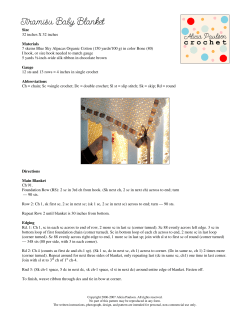
ITER blanket technology approved
Michel Claessens michel.claessens@iter.org +33-(0)6.14.16.41.75 ITER blanket technology approved SAINT-PAUL-LEZ-DURANCE, France (18 April 2013). The design of the ITER blanket system, a crucial technology on the way to fusion power, has been approved and is now ready to proceed to the manufacturing stage. “The development and validation of the final design of the ITER blanket and first wall technology is a major achievement on our way to deuteriumtritium operation—the main goal of the ITER project,” says Rene Raffray, in charge of the blanket for the ITER Organization. “We are looking at a first-of-a-kind fusion blanket which will operate in a first-of-a-kind fusion experimental reactor.” The ITER blanket system provides the physical boundary for the plasma and contributes to the thermal and nuclear shielding of the vacuum vessel and the external machine components such as the superconducting magnets operating in the range of 4 Kelvin (-269°C). Directly facing the ultra-hot plasma and having to cope with large electromagnetic forces, while interacting with major systems and other components, the blanket is arguably the most critical and technically challenging component in ITER. The blanket consists of 440 individual modules covering a surface of 600 m2, with more than 180 design variants depending on the segments’ position inside the vacuum vessel and their functionality. Each module consists of a shield block and first wall, together measuring 1 x 1.5 metres and weighing up to 4.5 tons—dimensions that not only demand sophisticated remote handling in view of maintenance requirements during deuterium-tritium operation, but also an approach to attaching the modules which is far from trivial when considering the enormous electromagnetic forces. The first wall is made out of shaped “fingers.” These fingers are individually attached to a poloidal beam, the structural backbone of each first wall panel through which the cooling water will be distributed. Depending on their position inside the vacuum vessel, these panels are subject to different heat fluxes. Two different kinds of panels have been developed: a normal heat flux panel designed for heat fluxes of up to 2 MW/m2 and an enhanced heat flux panel designed for heat fluxes of up to 4.7 MW/m2. The enhanced heat flux panels are located in areas of the vacuum vessel with greater plasmawall interaction and they make use of the hyper-vapotron technology, which is similar to that used for the divertor dome elements. All panels are designed for up to 15,000 full power cycles and are planned to be replaced at least once during ITER’s lifetime. A sophisticated R&D program is currently under way in Japan for the development of remote handling tools to dismantle and precisely re-position the panels. Due to the high heat deposition expected during plasma operation—the blanket is designed to take a maximum thermal load of 736 MW—ITER will be the first fusion device with an actively cooled blanket. The cooling water is fed to and from the shield blocks through manifolds and branch pipes. Furthermore, the modules have to provide passage for the multiple plasma diagnostic technologies, for the viewing systems, and for the plasma heating systems. Because of its low plasma-contamination properties, beryllium has been chosen as the element to cover the first wall. Other materials used for the blanket system are CuCrZr for the heat sink, ITER-grade steel 316L(N)-IG for the steel structure, Inconel 818 for the bolts and cartridges, an aluminium-bronze alloy for the pads that will buffer the electromechanical loads acting on the segments, and alumina for the insulating layer. The procurement of the 440 shield blocks is equally shared between China and Korea. The first wall panels will be manufactured by Europe (50%), Russia (40%) and China (10%). Russia will, in addition, provide the flexible supports, the key pads and the electrical straps. The preparation of the Procurement Arrangements will now be launched leading to the fabrication hand-over starting at the end of this year. The assembly of the ITER blanket system is scheduled for the second assembly phase of the ITER machine starting in May 2021 and lasting until August 2022. BACKGROUND TO THE PRESS RELEASE ITER, currently under construction in the south of France, is designed to demonstrate the scientific and technological feasibility of fusion power. In an unprecedented international effort, seven partners—China, the European Union, India, Japan, Korea, Russia and the United States—have pooled their financial and scientific resources to take fusion energy to the threshold of industrial exploitation. The completion of the construction is expected in 2020. More information on the ITER project can be found at: www.iter.org Page 2
© Copyright 2025



















